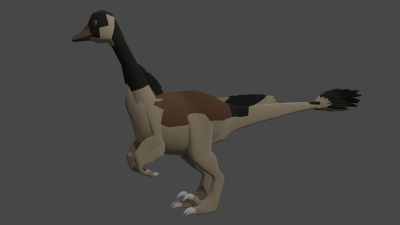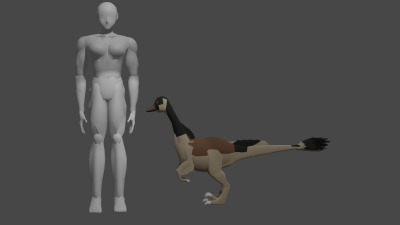Table of Contents
Nepleslian Guttersnipe
The Nepleslain Guttersnipe (Commonly known as the Craptor) is a bio-engineered invasive species of predators originating from planet Wetmud of the P1-6 "Freemud" system. They are known for their prolific breeding habbits, considerable inteligence, and pack-hunting mentality.
More about the Guttersnipe
A guttersnipe is a Nepleslian species of bipedal avian-raptors created through distant bio-engineering potentially centuries ago for purposes unknown and released on the, at the time, uninhabited planet of Wetmud. Due to their extremely aggressive nature being offset by ease of training and domestication when hatched it is quite possible they were designed and intended to combat some rival species of invasive predator on the planet centuries earlier but either by a population explosion or abandonment by potential settlers before colonization could take place the guttersnipes population was left unchecked and exploded over the generations.
History
Guttersnipes where first discovered by Nepleslian colonists upon landing and settling on Wetmud in YE 31. They where originally hunted as dangerous game and invasive pest animals until colonists began falling prey to them when conventional hunting tactics stopped working and packs adapted to overwhelm or outsmart settlers. Eventually after enough hunters and colonist groups came under attack by such invasive pests tests were run on them and their DNA to devise if chemical or biological culling was possible.
These tests discovered modified DNA markers from different species and lead researchers to believe that the guttersnipe was a biologically engineered species. Degraded genetic markers also sugested in place triggers towards easy domestication to re-introduce them to domestication or captivity. These markings, several generations old, implied that the species was seeded on the world hundreds of years prior; Despite no known colonization being catalouged, and was intended to be a highly-adaptable hunter-predator with minimal threat towards Nepleslian settlers.
Guttersnipes where re-introduced to Nepleslian ecology lists shortly after as a domesticatable species.
Appearance
Guttersnipes most commonly resemble a close family member in the form of the much smaller Goose. Sharing much the same plumage and body shape and structure of their sister species but being offset by more predator desirable traits such as muscular raptor-like legs ending in deadly hooked claws, long and dexterous arms ending in three taloned claws with a fourth dew-claw that acts as a dexterous thumb for manipulation.
The overall largest difference between the guttersnipe and the once common goose is its size compared to the former; Weighing in at an average of 70-100lbs and reaching a height of up to three feet from claw to head, and a length of six to seven feet from beak to tail.
Each guttersnipe is covered in a plumage of feathers that lengthen around the plume, arms, and both the base and tip of the tail. These feathers do not allow them to fly, but instead, help with aerodynamics and drag when sprinting or lunging.
Capabilities
Guttersnipes are pack hunters by nature; With each pack containing between five to twenty raptors with an alpha-raptor pack leader. Each gutternsipe is extremely intelligent and clever and capable of advanced problem solving allowing pack members to communicate, plan, and execute complex and intelligent actions that defy most people's disbelief of most animals' intellectual ability.
Such actions could involve complex ambushes, distractions, complicated maneuvers and formations, using their thumbed dew-claws to open doors or move or even disturb objected such as carrying or throwing them, communicating long distance through honking calls to other pack members to alert or communicate actions, etc.
Each guttersnipe is also deadly solo in their own right; Containing not only the talons on their feet and hands that can tear through light armors, but also a segmented jaw that splits from a traditional beak into four segmented mandibles that spread open much like four flower petals that can clamp down on and tear at prey with sharp and deadly teeth. The jaw and mouth-beak also contain a long and spiked tongue that can easily remove the flesh off of bone.
Guttersnipes can easily traverse most terrains due to the swampy nature of their world and can even swim and climb trees and objects alike.
Personality
Guttersnipes are naturally aggressive and territorial by nature. A long snipe would not hesitate to take on a much larger predator if provoked but more often than not are prone to summon a larger pack of equally aggressive and territorial raptor-fowl.
Each snipe is also extremely intelligent and capable of understanding gestures, actions, and even sounds, language, and tone. A snipe is smart enough to figure out things such as latches or doorknobs and understands object permanence enough to understand the concept of a building interior or where an object might be in relation to having seen it placed in a container or bag. They are intelligent enough to remember faces and smells and even to recognize posture and objects such as firearms and tools and how they are held and what they might do if whitnessed.
Despite these traits, the common guttersnipe prefers stealth hunting of prey if possible but is not against outright hunting of prey with its pack and is known to herd and lure prey into dead-ends and towards larger groups of the pack waiting in ambush.
When guttersnipes are happy they tend to jump up and down, flapping their winged arms or running around in circles. When upset or mad they tend to hiss or honk very loudly and lower their body posture as if to strike.
Diet
Guttersnipes are omnivorous by nature but prefer a high-protein diet. They can and will eat anything from grains, fruits, vegetables, and meats but prefer meat overall.
They feed often once or twice a week if hunting but can subsist off of more frequent and smaller meals and foods. A downside is that, like their ancestors, they defecate often.
Life Cycle and Reproduction
Guttersnipes begin the first year of their life outside of the egg as young goslings roughly the size of a small chicken and growing to the size of a moderately sized swan by the time they enter their juvenile stage at the peak of their first year. During this first year, goslings stay within the packs nest-clusters (or in a singular nest if with a lone or parent family) and learn socializing behavior by pretend hunting and fighting and from their mothers who, along with other females in the gander will form a communal cluster to mutually guard their eggs or goslings from predators. The diet of goslings at this age consists of small bugs, slow amphibians, and regurgitated foodstuffs from hunting parents.
At the peak of their first year, goslings are large enough to safely venture away from the nest and are often ejected by their parents from the nest to hunt small animals and to feed themselves. This period in a young goslings life teaches them valuable experience around hunting and stalking of prey, and accompanying scents and sounds outside the nest. Young goslings will often stick together and hunt in small micro-packs that will either hunt their own prey or attempt to scavenge kills of the large pack.
Goslings are considered fully grown and mature adults by the time they reach three years of age and are often subject to incorporation into the large hunting pack or outright chased out of the packs' territory to wander or start their own if guttersnipe communities are overburdened in numbers. Now adult guttersnipes who are chased away from the pack often start their own in traveling packs until they can settle their own territory, or in some cases will adopt into small or decimated guttersnipe communities without enough hunting raptors.
At this point in their life a guttersnipe is also sexually mature and will start to grow its pruning feathers. Males often compete in exuberant dancing-like rituals by running in circles, jumping, and waving or shaking their feathers to try to attract a fertile female during a brief two-week mating period that syncs across a pack and can be at a different time of the year depending on the pack.
Younger males often do not get to mate despite their efforts as younger females will seek out larger or stronger males from the hunting pack and will stay with their partner until the next mating season. As a mating season comes to a close, if there are still females willing to mate and have yet to choose a mate, males will often turn from passive mating efforts into more active ones and will begin nipping and fighting amongst themselves to try to impress a mate.
As there are always more males in a pack than females it is not uncommon for most of the pack to not find a mate. The leftover testosterone from non-mating males will often settle and, as a biological feature, will enhance the males' growth and size to make them slightly larger and stronger to give them a better chance next mating season.
After mating, females will often leave the hunting pack and will create a communal nesting cluster with other females and will begin laying anywhere from one to five eggs. Eggs are often the size of a softball and are oval in shape and take up to fourty days to hatch. Survival rates for eggs from laying to hatching are often 40% and its not uncommon to lose a couple eggs to predators or spoiling.
The average guttersnipe from hatching to their death are engineered to live in ideal conditions up to thirty years. The average lifespan is somwhat less due to predation, injury, or death.
Domestication
Imprinting from the moment of hatching, usually in large nest clusters guarded by nesting females, guttersnipes are surprisingly easy to domesticate and train from a young age. Imprinting onto a person compared to other snipes makes them more receptive to people.
Simply tailored cybernetics in the form of a chip placed in the guttersnipes head that controls their serotonin levels trains them at birth that their handlers or trainers presence will release serotonin when in training as compared to triggering aggression or territorial behavior. This method imprints that their trainer or handler is not only part of their pack but triggers the same submission chemicals as being in the presence of a packs alpha. When properly domesticated a guttersnipe might now show love and care towards their handlers or masters but will allow themselves to be handled, carried, touched, petted, or interacted with without showing aggression or violence and are even safe around other animals and even children; Only showing aggression or attacking when commanded by their handler or if denied their instincts to hunt for too long such as being kenneled or locked away for extended periods of time.
Snipes are easily trained to understand and execute commands and can communicate with honks or actions back. They are not uncommon pets for mercenaries or avid game hunters but are also not infrequently found in military use such as patroling pack animals for IPG facilities such as in System P1-10 "Dejection" to hunt down intruders or escaping prisoners. Or as pets on ships much to the dismay of those tasked with keeping those ships clean.
OOC Notes
Charmaylarg created this article on 2021/05/04 13:45.
Approval thread here

